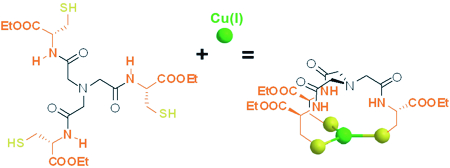Copper plays a role in many biological processes, such as oxygen transport or the reduction of oxygen in water. However, copper overload in the body is very toxic and leads to severe problems in both the liver and in the nervous system. For instance, Wilson’s disease is one of the major genetic disorders of Cu metabolism in humans (1 over 40 000 people). Soluble copper exists in two oxidized states: Cu(II) and Cu(I). In food, it is present as Cu(II), which is more stable in air. In cells, copper is present as Cu(I) and therefore has a great affinity for sulfur-based compounds. That’s why copper trafficking and sequestering proteins have a large number of amino acids containing sulfur atoms: cysteins.
We have designed a molecule to encapsulate copper in cells, and promote its elimination. This molecule derives from a compound known to bind calcium and magnesium, for instance in washing powders, and is functionalized with three cysteins. This molecule shows a very high affinity for Cu(I)
in vitro, without interfering with other ions present in cells like zinc(II). To use this system
in vivo, the copper-binding molecule will be functionalized with a recognition unit to selectively target it to hepatic cells.

Copper encapsulation by our ligand.
The “pincer” formed by the 3 cysteins (orange) captures copper in Cu(I) state (green) thanks to the three sulfur atoms (yellow).